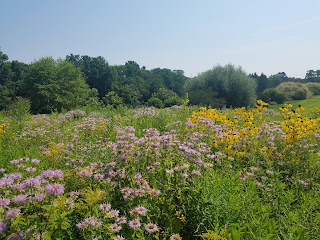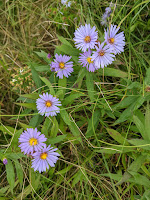Shade Garden!
 |
| Does full sun even need a design? |
 |
| Viburnum acerfolium. |
 |
| Garden in the woods. |
But nature tells stories in the shade that are drowned by the light of the full sun. Like ripples in still water that could never be seen in the presence of crashing waves, in the share we can find patterns in the ridges in leaves or the arc of elongated stems, that they eye would overlook in the full sun where plants struggle to capture all available space and water. It takes time, but if we are to return our urban landscapes to nature, then we must learn to appreciate nature in both the sun and shade.

This fall I re-purposed a 400 square foot chicken run under sugar maple trees as a shade garden. To feed the chickens and provide cover, I had planted aronia melanocarpa (black chokeberry), aronia arbutifolia (red chokeberry), and lindera benzoin (spicebushes) two years before. I loved raising chickens but I found that it was too difficult to raise a small flock in an urban environment and allow them to forage. A friend was looking to increase the size of her flock, so I knew they would be going to a good place where they would be able to forage.
 Fortunately, the chickens had broken down leaves and improved the soil which was a bark mulched play area two years ago. First, I scattered buckwheat seeds to help increase the organic content and also absorb nutrients in the former chicken pen. I purchased a shade tolerant plant mix from Prairie Moon Nursery, Shady Woodland Seed Mix. This is a great seed mix with a very diverse mixture of plants suited or suitable to the northeast. I threw in seeds of a few shrubs and others that I had as extras. I also added a local variety of black eyed coneflowers (Rudbeckia hirta pulcherima) I obtained from the Wild Seed Project because, even though the area is intended to be a shade garden, this plant would add from color and reward in
Fortunately, the chickens had broken down leaves and improved the soil which was a bark mulched play area two years ago. First, I scattered buckwheat seeds to help increase the organic content and also absorb nutrients in the former chicken pen. I purchased a shade tolerant plant mix from Prairie Moon Nursery, Shady Woodland Seed Mix. This is a great seed mix with a very diverse mixture of plants suited or suitable to the northeast. I threw in seeds of a few shrubs and others that I had as extras. I also added a local variety of black eyed coneflowers (Rudbeckia hirta pulcherima) I obtained from the Wild Seed Project because, even though the area is intended to be a shade garden, this plant would add from color and reward in the early years and I do not think it will take over or be aggressive.
 To plant the seed mix, I placed it in a large bowl and added water and the seeds in mid to late November, after the temperatures had become consistently cold, but there were still fall rains and freeze thaw cycles that are critical to germination of wildflower mixes. The seed mix had an agriculture type grass, I believe a rye, that is sterile. This is important because it will help keep invasive weeds from colonizing the soil in the first year. Thereafter it will not re-seed which will allow the slow growing shade plants to become established. Prairie Mood recommends that the first year growth be mowed or cut back at the end of the year.
To plant the seed mix, I placed it in a large bowl and added water and the seeds in mid to late November, after the temperatures had become consistently cold, but there were still fall rains and freeze thaw cycles that are critical to germination of wildflower mixes. The seed mix had an agriculture type grass, I believe a rye, that is sterile. This is important because it will help keep invasive weeds from colonizing the soil in the first year. Thereafter it will not re-seed which will allow the slow growing shade plants to become established. Prairie Mood recommends that the first year growth be mowed or cut back at the end of the year. Another measure I used to help prevent invasive species from colonizing the exposed soil was to rake sugar maple leaves from the hard into piles which I then ran over repeatedly with an electric lawn mower. This is a great technique to improve soil because the mechanical mowing greatly increases the surface area and decomposition. By breaking the leaves into smaller pieces, this also makes it easier for the seeds to grow to the sunlight in the spring, while still holding moisture.
Another measure I used to help prevent invasive species from colonizing the exposed soil was to rake sugar maple leaves from the hard into piles which I then ran over repeatedly with an electric lawn mower. This is a great technique to improve soil because the mechanical mowing greatly increases the surface area and decomposition. By breaking the leaves into smaller pieces, this also makes it easier for the seeds to grow to the sunlight in the spring, while still holding moisture.Needless to say, I am excited for spring to come to this years and watch what life comes to my urban shade oasis.






Comments
Post a Comment